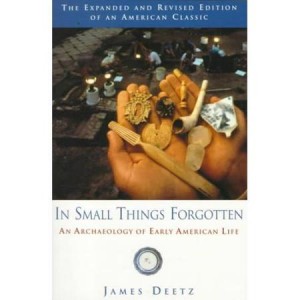Attempting to pick a favorite book for 2015 was difficult task because many of the books that I have read this year have been books that I have read in the past and of those several  were non-fiction. James Deetz (1930-2000), former University of Virginia archaeology professor, book In Small Things Forgotten is one book worth rereading. Deetz maintains his argument that understanding the significance of simple artifacts may give deeper insight into American history than letters journals and other written documents. In his 1996 edition, Deetz expanded many of the chapters and added an entire chapter on Africans and African-Americans, their artifacts, and lifestyles.
were non-fiction. James Deetz (1930-2000), former University of Virginia archaeology professor, book In Small Things Forgotten is one book worth rereading. Deetz maintains his argument that understanding the significance of simple artifacts may give deeper insight into American history than letters journals and other written documents. In his 1996 edition, Deetz expanded many of the chapters and added an entire chapter on Africans and African-Americans, their artifacts, and lifestyles.
Deetz examines the definition of historical archaeology, as well as historical archaeologists’ relationships to material culture and how a site and its artifacts are important. Now this might sound a bit academic, but Deetz is able to write in a way that makes his work accessible and interesting to many outside the world of history. He also uncovers archaeology’s relationship with the historical record. For example, Deetz reveals that bones of wild animals were found in many African-American cellars and he hypothesizes that slaves most likely ate them to supplement their diet. This indicates that slaves had free time to hunt, which contradicts the historical record, which assumes that their white owners fully controlled their lives. Deetz mainly covers New England and the Chesapeake area because those are the locations of sites that he where he did the majority of his work. Although Deetz touches on the national and international context of his findings, for the most part he maintains a regional focus.
By studying everyday objects like dishes, houses, and gravestones, Deetz clearly draws the connection between history and archaeology, as well as the relationship to modern day life. Each chapter of In Small Things Forgotten explores a different aspect of historical archaeology. For example, chapter five, “I Would Have the Howse Stronge in Timber,” is especially fascinating because Deetz examines houses as material culture and writes about how saving houses creates its own issues. The last chapter, on Africans and African-Americans in America, is the most interesting. The written record is predominantly from white landowners and so the artifacts that slaves left behind allow historians to better understand their daily lives. Deetz also details how European housing differs from the housing that African-Americans had in America. Interestingly, he finds that the shotgun houses in America are more similar to those found in Haiti than those in West Africa.
Deetz uses a variety of sources throughout the book to support his arguments, including photos, journals, articles and books. A few of these sources include Noel Hume’s A Guide to Artifacts of Colonial America, which is a great book to help date early American objects and William Bradford’s Of Plymouth Plantation 1620-1647. The numerous illustrations are useful and well drawn, adding significantly to the book’s readability because they help to visually explain Deetz’s arguments.
While it is a pleasure to read Deetz’s In Small Things Forgotten, it also features clear language and structure. The book provides a new way to learn about early America because it serves as a counterpoint to the written record. Deetz has successfully updated this detailed and insightful book, explaining the importance of seemingly insignificant artifacts in a straightforward. It is a book that one can reread several times and continue to learn something new. The book is recommended for those interested in early American history or even those interested in genealogy.
http://evergreen.noblenet.org/eg/opac/record/1489233?locg=1
Erik Bauer
Archivist
